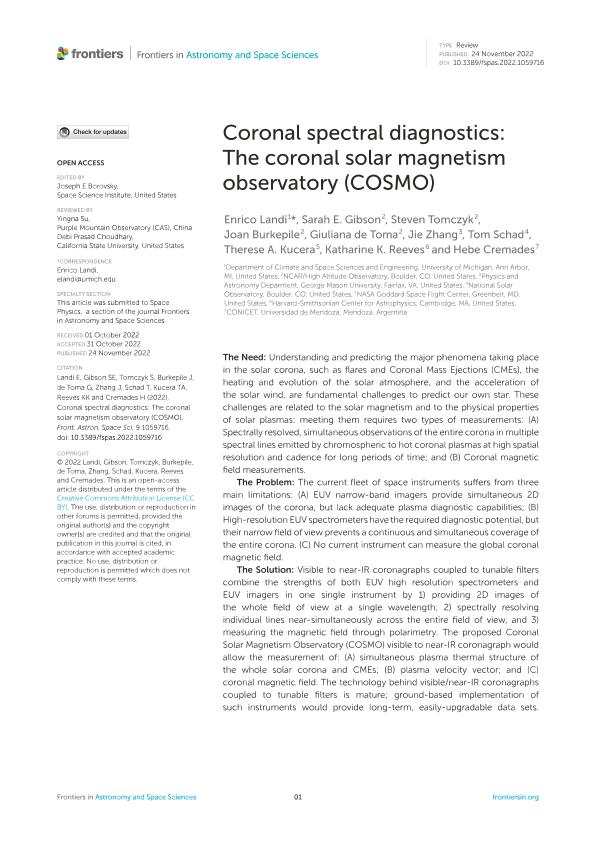Mostrar el registro sencillo del ítem
dc.contributor.author
Landi, Enrico
dc.contributor.author
Gibson, Sarah E.
dc.contributor.author
Tomczyk, Steven
dc.contributor.author
Burkepile, Joan
dc.contributor.author
de Toma, Giuliana
dc.contributor.author
Zhang, Jie
dc.contributor.author
Schad, Tom
dc.contributor.author
Kucera, Therese A.
dc.contributor.author
Reeves, Katharine K.
dc.contributor.author
Cremades Fernandez, Maria Hebe

dc.date.available
2023-11-23T15:34:37Z
dc.date.issued
2022-11
dc.identifier.citation
Landi, Enrico; Gibson, Sarah E.; Tomczyk, Steven; Burkepile, Joan; de Toma, Giuliana; et al.; Coronal spectral diagnostics: The coronal solar magnetism observatory (COSMO); Frontiers Media; Frontiers in Astronomy and Space Sciences; 9; 1059716; 11-2022; 1-7
dc.identifier.uri
http://hdl.handle.net/11336/218542
dc.description.abstract
The Need: Understanding and predicting the major phenomena taking place in the solar corona, such as flares and Coronal Mass Ejections (CMEs), the heating and evolution of the solar atmosphere, and the acceleration of the solar wind, are fundamental challenges to predict our own star. These challenges are related to the solar magnetism and to the physical properties of solar plasmas: meeting them requires two types of measurements: (A) Spectrally resolved, simultaneous observations of the entire corona in multiple spectral lines emitted by chromospheric to hot coronal plasmas at high spatial resolution and cadence for long periods of time; and (B) Coronal magnetic field measurements. The Problem: The current fleet of space instruments suffers from three main limitations: (A) EUV narrow-band imagers provide simultaneous 2D images of the corona, but lack adequate plasma diagnostic capabilities; (B) High-resolution EUV spectrometers have the required diagnostic potential, but their narrow field of view prevents a continuous and simultaneous coverage of the entire corona. (C) No current instrument can measure the global coronal magnetic field. The Solution: Visible to near-IR coronagraphs coupled to tunable filters combine the strengths of both EUV high resolution spectrometers and EUV imagers in one single instrument by 1) providing 2D images of the whole field of view at a single wavelength; 2) spectrally resolving individual lines near-simultaneously across the entire field of view, and 3) measuring the magnetic field through polarimetry. The proposed Coronal Solar Magnetism Observatory (COSMO) visible to near-IR coronagraph would allow the measurement of: (A) simultaneous plasma thermal structure of the whole solar corona and CMEs; (B) plasma velocity vector; and (C) coronal magnetic field. The technology behind visible/near-IR coronagraphs coupled to tunable filters is mature; ground-based implementation of such instruments would provide long-term, easily-upgradable data sets.
dc.format
application/pdf
dc.language.iso
eng
dc.publisher
Frontiers Media

dc.rights
info:eu-repo/semantics/openAccess
dc.rights.uri
https://creativecommons.org/licenses/by/2.5/ar/
dc.subject
CORONA
dc.subject
GROUND BASED INSTRUMENTS
dc.subject
IMAGING SPECTROSCOPY
dc.subject
PLASMA DIAGNOSTICS
dc.subject
VISIBLE RADIATION
dc.subject.classification
Astronomía

dc.subject.classification
Ciencias Físicas

dc.subject.classification
CIENCIAS NATURALES Y EXACTAS

dc.title
Coronal spectral diagnostics: The coronal solar magnetism observatory (COSMO)
dc.type
info:eu-repo/semantics/article
dc.type
info:ar-repo/semantics/artículo
dc.type
info:eu-repo/semantics/publishedVersion
dc.date.updated
2023-11-15T15:53:23Z
dc.identifier.eissn
2296-987X
dc.journal.volume
9
dc.journal.number
1059716
dc.journal.pagination
1-7
dc.journal.pais
Suiza

dc.journal.ciudad
Lausana
dc.description.fil
Fil: Landi, Enrico. University of Michigan; Estados Unidos
dc.description.fil
Fil: Gibson, Sarah E.. National Center for Atmospheric Research; Estados Unidos
dc.description.fil
Fil: Tomczyk, Steven. National Center for Atmospheric Research; Estados Unidos
dc.description.fil
Fil: Burkepile, Joan. National Center for Atmospheric Research; Estados Unidos
dc.description.fil
Fil: de Toma, Giuliana. National Center for Atmospheric Research; Estados Unidos
dc.description.fil
Fil: Zhang, Jie. George Mason University; Estados Unidos
dc.description.fil
Fil: Schad, Tom. National Solar Observatory; Estados Unidos
dc.description.fil
Fil: Kucera, Therese A.. National Aeronautics and Space Administration; Estados Unidos
dc.description.fil
Fil: Reeves, Katharine K.. Harvard-Smithsonian Center for Astrophysics; Estados Unidos
dc.description.fil
Fil: Cremades Fernandez, Maria Hebe. Universidad de Mendoza; Argentina. Consejo Nacional de Investigaciones Científicas y Técnicas. Centro Científico Tecnológico Conicet - Mendoza; Argentina
dc.journal.title
Frontiers in Astronomy and Space Sciences
dc.relation.alternativeid
info:eu-repo/semantics/altIdentifier/doi/http://dx.doi.org/10.3389/fspas.2022.1059716
dc.relation.alternativeid
info:eu-repo/semantics/altIdentifier/url/https://www.frontiersin.org/articles/10.3389/fspas.2022.1059716/full
Archivos asociados
